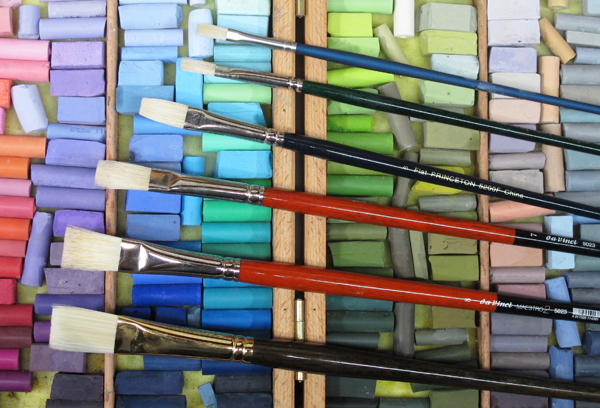Brush Up Your Pastel Palette | Choosing Sticks for a Painterly Effect

Although pastel is a dry medium, which can be applied in a drawn manner and producing line, many pastelists consider their techniques to be more closely associated with the techniques of wet media. This association makes the size and characteristics of the individual pastel sticks contained within a pastel palette very important; they are akin to the various brushes one would utilize when painting with a wet medium like oils.

A Painterly Style Emerges: Manufacturers have historically offered pastels in round stick form. The length and circumference of the sticks often varied between brands. Paper labels were applied for inventory purposes, keeping the ends of the sticks exposed for visual comparison. In this form, artists could easily make consistent marks and keep their hands relatively clean by gripping the label. As a stick became worn, portions of the label would be peeled off, exposing fresh pigment. Eventually the size of the stick became too small to easily hold or the artist removed the label and broke the stick. With the stick in this form, it became easier to apply in the fashion of paint from a brush. As the mindset of “painting” with pastel became more popular, many manufacturers began to offer sticks with squared sides that more closely compare to the chiseled edge of a brush. While it may not have been their intention, it has facilitated a shift among pastelists towards a more painterly application.
Inside Your Pastel Palette: When deciding on a stick size for your individual pastel palette, think of the size of marks (brushstrokes) you prefer to make. If you typically make large sweeping marks, larger edged sections of pastels will be useful. On the other hand, if you typically make small marks, smaller pieces of pastel will suffice. A popular size among many pastelists is the half-stick, especially when the stick is square-sided. It allows for broad chisel marks on the long sides, smaller chisel marks on the two ends, and tiny marks from the tips. This one pastel stick has the versatility of a wide range of brushes. If this stick size appeals to you, consider purchasing pastels that are already half-size. Many popular manufacturers now offer large assortments in this convenient dimension. Otherwise, carefully prepare your full-size sticks to a size that appeals to your painting personality.
Another consideration when comparing a pastel stick to painting is to think of the viscosity. Harder pastel brands are similar to thicker paint; they require more application pressure. Softer pastel brands are like buttery fluid paint; they easily flow off.
While size may not always matter, when it comes to setting up a useful pastel palette, the size of your pastel stick does matter. It facilitates your intent, providing a more satisfying outcome.
• Sign up for your Pastel Journal email newsletter & download a FREE issue of Pastel Journal magazine
MORE RESOURCES FOR ARTISTS
• Get unlimited access to over 100 art instruction ebooks
• Online seminars for fine artists
• Learn how to paint & how to draw with downloads, books, videos & more from North Light Shop
• Subscribe to The Artist’s Magazine
• Sign up for your Artist’s Network email newsletter & download a FREE issue of The Artist’s Magazine





Have a technical question?
Contact UsJoin the Conversation!